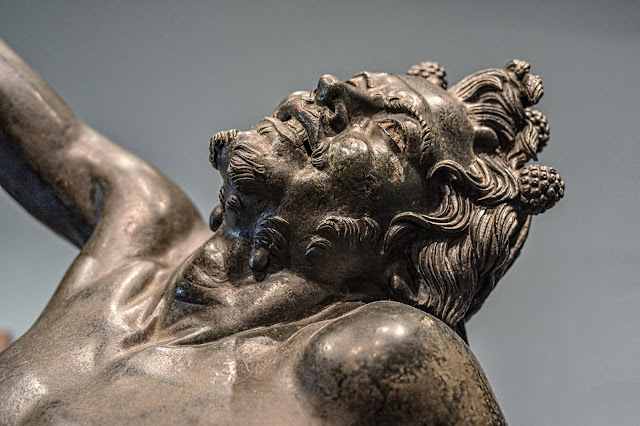Selected Sculptures from the exhibit Buried by Vesuvius, Treasures from the Villa dei Papiri through October 28, 2019 at the Getty Villa In Pacific Palisades, California
Selected Sculptures from the exhibit Buried by Vesuvius, Treasures from the Villa dei Papiri through October 28, 2019 at the Getty Villa In Pacific Palisades, California.
A large collection of bronze and marble statuary as well as a thousand papyrus scrolls were rediscovered in the 1750s and 1760s when the ancient villa on the cliffs adjacent to the town of Herculaneum was excavated from the volcanic debris of the eruption of Mount Vesuvius in 79 CE. For the next few days, we will examine some of these art objects that are featured in the current exhibit. First of the objects is the famous drunken satyr, a replica of which basks in the sun in the Getty's large reflection pool in the outer peristyle. Of the 65 statues and busts found at the archaeological site, the Drunken Satyr is considered the most impressive. The statue did not emerge from the 80 feet of volcanic rock and debris intact, however. The right arm and left hand had become detached, and much of the lion pelt and wineskin on which the figure rests was lost. Restoration at the nearby royal palace of Portici followed. The bronze was repatinated, meaning it was heated or chemically treated to give its surface a more uniform, dark-black appearance. Originally it would have been a golden bronze hue, perhaps approximating the color of tanned flesh. The eyes were inlaid with bone and colored stone or glass, the lips coated with red copper, and the teeth, at least those that remain (for the Satyr is depicted missing several), were coated with tin - all giving this rowdy follower of the wine-god Bacchus a vivid appearance.
https://blogs.getty.edu/iris/an-introduction-to-the-drunken-satyr-a-rare-roman-bronze-being-studied-and-conserved-at-the-getty-villa/
Image: Closeup of the drunken satyr 1st century BCE from the Villa dei Papiri courtesy of Allan Gluck.
A large collection of bronze and marble statuary as well as a thousand papyrus scrolls were rediscovered in the 1750s and 1760s when the ancient villa on the cliffs adjacent to the town of Herculaneum was excavated from the volcanic debris of the eruption of Mount Vesuvius in 79 CE. For the next few days, we will examine some of these art objects that are featured in the current exhibit. First of the objects is the famous drunken satyr, a replica of which basks in the sun in the Getty's large reflection pool in the outer peristyle. Of the 65 statues and busts found at the archaeological site, the Drunken Satyr is considered the most impressive. The statue did not emerge from the 80 feet of volcanic rock and debris intact, however. The right arm and left hand had become detached, and much of the lion pelt and wineskin on which the figure rests was lost. Restoration at the nearby royal palace of Portici followed. The bronze was repatinated, meaning it was heated or chemically treated to give its surface a more uniform, dark-black appearance. Originally it would have been a golden bronze hue, perhaps approximating the color of tanned flesh. The eyes were inlaid with bone and colored stone or glass, the lips coated with red copper, and the teeth, at least those that remain (for the Satyr is depicted missing several), were coated with tin - all giving this rowdy follower of the wine-god Bacchus a vivid appearance.
https://blogs.getty.edu/iris/an-introduction-to-the-drunken-satyr-a-rare-roman-bronze-being-studied-and-conserved-at-the-getty-villa/
Image: Closeup of the drunken satyr 1st century BCE from the Villa dei Papiri courtesy of Allan Gluck.




Comments
Post a Comment